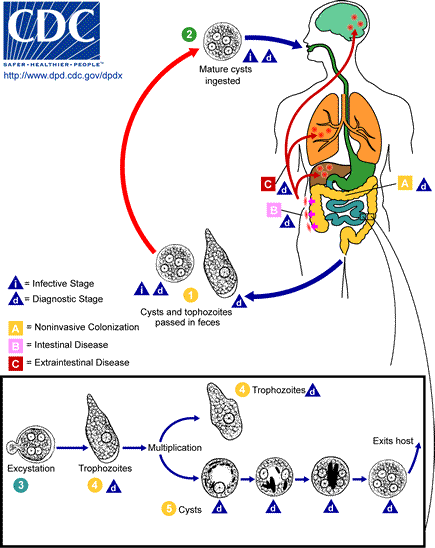Entamoeba histolytica
| Entamoeba histolytica | |
|---|---|
 Entamoeba histolytica | |
| Videnskabelig klassifikation | |
| Domæne | Eukaryota |
| Rige | Protozoa (Protozo) |
| Række | Amoebozoa |
| Klasse | Archamoebea |
| Orden | Pelobiontida |
| Familie | Entamoebidae |
| Slægt | Entamoeba |
| Art | E. histolytica |
| Videnskabeligt artsnavn | |
| Entamoeba histolytica Schaudinn, 1903 | |
| Hjælp til læsning af taksobokse | |
Entamoeba histolytica er en anaerob protozo, der inficerer menesker, og forårsager sygdommen amøbedysenteri (amøbiasis). De findes overvejende i troperne.
De findes i to stadier: som frie amøber, også kaldet trophozoiter og som indkapslede cyster. Det er i cysteformen at de kan smitte, idet de indkapslede cyster kan overleve turen gennem fordøjelsessystemet. De udskilles med afføringen hos inficerede, og ved dårlig hygiejne smitter de "fækalt-oralt".
Kilder/henvisninger
| Wikimedia Commons har medier relateret til: |
- Systema naturae 2000 (classification) – Taxon: Entamoeba histolytica Arkiveret 4. marts 2016 hos Wayback Machine
|
Medier brugt på denne side
Amebiasis [Entamoeba histolytica]
Life Cycle of Entamoeba histolytica
Cysts and trophozoites are passed in feces . Cysts are typically found in formed stool, whereas trophozoites are typically found in diarrheal stool. Infection by Entamoeba histolytica occurs by ingestion of mature cysts in fecally contaminated food, water, or hands. Excystation occurs in the small intestine and trophozoites are released, which migrate to the large intestine. The trophozoites multiply by binary fission and produce cysts , and both stages are passed in the feces . Because of the protection conferred by their walls, the cysts can survive days to weeks in the external environment and are responsible for transmission. Trophozoites passed in the stool are rapidly destroyed once outside the body, and if ingested would not survive exposure to the gastric environment. In many cases, the trophozoites remain confined to the intestinal lumen ( : noninvasive infection) of individuals who are asymptomatic carriers, passing cysts in their stool. In some patients the trophozoites invade the intestinal mucosa ( : intestinal disease), or, through the bloodstream, extraintestinal sites such as the liver, brain, and lungs ( : extraintestinal disease), with resultant pathologic manifestations. It has been established that the invasive and noninvasive forms represent two separate species, respectively E. histolytica and E. dispar. These two species are morphologically indistinguishable unless E. histolytica is observed with ingested red blood cells (erythrophagocystosis). Transmission can also occur through exposure to fecal matter during sexual contact (in which case not only cysts, but also trophozoites could prove infective).Trophozoites of Entamoeba histolytica with ingested erythrocytes (trichrome stain). The ingested erythrocytes appear as dark inclusions. Erythrophagocytosis is the only characteristic that can be used to differentiate morphologically E. histolytica from the nonpathogenic E. dispar. In these specimens, the parasite nuclei have the typical small, centrally located karyosome, and thin, uniform peripheral chromatin.



